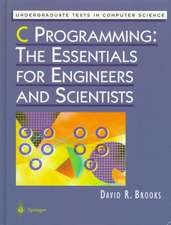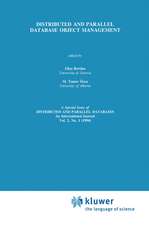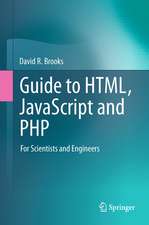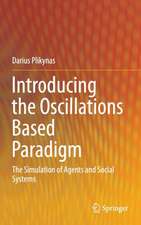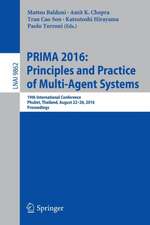Problem Solving with Fortran 90: For Scientists and Engineers: Undergraduate Texts in Computer Science
Autor David R. Brooksen Limba Engleză Paperback – 23 oct 2012
Preț: 361.77 lei
Preț vechi: 452.21 lei
-20% Nou
Puncte Express: 543
Preț estimativ în valută:
69.23€ • 72.61$ • 57.63£
69.23€ • 72.61$ • 57.63£
Carte tipărită la comandă
Livrare economică 01-15 aprilie
Preluare comenzi: 021 569.72.76
Specificații
ISBN-13: 9781461273530
ISBN-10: 1461273536
Pagini: 720
Ilustrații: XXXIV, 682 p.
Dimensiuni: 178 x 254 x 38 mm
Greutate: 1.23 kg
Ediția:Softcover reprint of the original 1st ed. 1997
Editura: Springer
Colecția Springer
Seria Undergraduate Texts in Computer Science
Locul publicării:New York, NY, United States
ISBN-10: 1461273536
Pagini: 720
Ilustrații: XXXIV, 682 p.
Dimensiuni: 178 x 254 x 38 mm
Greutate: 1.23 kg
Ediția:Softcover reprint of the original 1st ed. 1997
Editura: Springer
Colecția Springer
Seria Undergraduate Texts in Computer Science
Locul publicării:New York, NY, United States
Public țintă
GraduateCuprins
1. Computing Environments for Problem Solving.- 1.1 A Brief History of Electronic Computing.- 1.2 The Academic Computing Environment.- 1.3 What Do You Need to Know About Your Computing Environment?.- 1.4 Fortran and the Personal Computing Environment.- 1.5 Is Programming Necessary Anymore?.- 1.6 Exercises.- 2. Solving Problems with a High-Level Programming Language.- 2.1 Structured Programming and Problem Solving.- 2.2 Designing Algorithms for Procedural Programming Languages.- 2.3 Program Modularization.- 2.4 Applications.- 2.5 Debugging Your Algorithms.- 2.6 Exercises.- 3. Getting Started with Fortran: Writing Simple Programs.- 3.1 A Simple Problem and a Fortran Program to Solve It.- 3.2 Program Layout.- 3.3 Declaring Variables and Defining Constants.- 3.4 List-Directed Input and Output.- 3.5 Arithmetic Operators, Assignment Statements, and Calculations.- 3.6 Program Termination.- 3.7 Compiling and Executing a Program.- 3.8 Applications.- 3.9 Debugging Your Programs.- 3.10 Exercises.- 4. Using Functions to Expand the Power of Fortran.- 4.1 Fortran Intrinsic Functions.- 4.2 Fortran Statement Functions.- 4.3 Applications.- 4.4 Debugging Your Programs.- 4.5 Exercises.- 5. Gaining Control Over Program Output.- 5.1 The Formatted PRINT Statement.- 5.2 The WRITE Statement.- 5.3 Saving Program Output.- 5.4 Applications.- 5.5 Debugging Your Programs.- 5.6 Exercises.- 6. Program Control: Branching and Repetitive Calculations.- 6.1 Using Program Control Structures.- 6.2 Relational and Logical Operators and the Fortran IF… Construct.- 6.3 The SELECT CASE Construct.- 6.4 Fortran Loop Constructs.- 6.5 Using Implied DO… Loops in Output Statements.- 6.6 Applications.- 6.7 Debugging Your Programs.- 6.8 Exercises.- 7. Program Modularization.- 7.1 Designing Modularized Algorithmswith the CALL and SUBPROGRAM Pseudocode Commands.- 7.2 Fortran Subroutines.- 7.3 Fortran Functions.- 7.4 Using Subroutines and Functions.- 7.5 Applications.- 7.6 Debugging Your Programs.- 7.7 Exercises.- 8. Using Arrays to Organize Information.- 8.1 Arrays in Structured Programming.- 8.2 Basic Array Implementation.- 8.3 Using Statically Allocated Arrays in Subprograms.- 8.4 Allocatable Arrays.- 8.5 Treating Strings of Characters as Arrays of Characters.- 8.6 The TYPE Statement, Records, and Arrays of Records.- 8.7 Applications.- 8.8 Debugging Your Programs.- 8.9 Exercises.- 9. Using Formatted Sequential Access and Internal Files.- 9.1 The Text File Concept.- 9.2 OPEN, READ, and CLOSE Statements for Sequential File Access.- 9.3 Files and Arrays.- 9.4 More About Formatted READ Statements.- 9.5 Writing Text Files.- 9.6 Applications.- 9.7 Debugging Your Programs.- 9.8 Exercises.- 10. Some Essential Programming Algorithms.- 10.1 Introduction.- 10.2 Searching Algorithms.- 10.3 Sorting Algorithms.- 10.4 Recursive Algorithms.- 10.5 The Recursive Quicksort Algorithm.- 10.6 Applications.- 10.7 Debugging Your Programs.- 10.8 Exercises.- 11. Basic Statistics and Numerical Analysis with Fortran.- 11.1 Introduction.- 11.2 Basic Descriptive Statistics.- 11.3 Numerical Differentiation.- 11.4 Numerical Integration.- 11.5 Solving Systems of Linear Equations.- 11.6 Finding the Roots of Equations.- 11.7 Numerical Solutions to Differential Equations.- 11.8 Exercises.- 12. A Closer Look.- 12.1 Introduction.- 12.2 Using More Than One Program Unit.- 12.3 The Internal Representation of Numbers and Extended Precision.- 12.4 Array Operations and Array Inquiry and Reduction.- 12.5 Direct Access and Unformatted (Binary) Files.- 12.6 The COMPLEX Data Type.- 12.7 Data Sharing With COMMON Blocks.- Appendices.- Appendix 1. Table of ASCII Characters for IBM-Compatible PCs.- Appendix 2. Summary of Pseudocode Commands and Fortran Statement Syntax.- Appendix 2.1 Pseudocode Commands.- Appendix 2.2 Fortran Statement Syntax.- Appendix 3. Source Code File Name Summary.- Appendix 4. Accessing the System Time and Date.
Caracteristici
A thorough guide to problem-solving and algorithm design using pseudo-code * Each chapter includes at least two complete programming applications which become progressively more challenging * Students new to computing will find the wide range of problems both accessible and relevant to their other studies * Includes a brief introduction to computing in general










